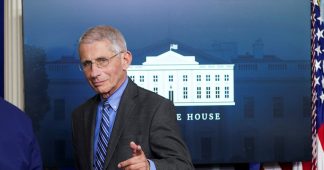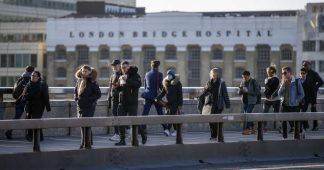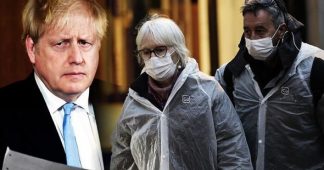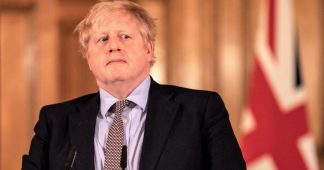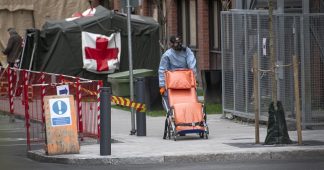The murderous pseudoscience of “herd immunity”
By Andre Damon
16 May 2020
On May 12, Foreign Affairs, the leading journal of the US foreign policy establishment, carried an article arguing for large portions of the US and world population to be infected with COVID-19. The article is headlined “Sweden’s Coronavirus Strategy Will Soon Be the World’s: Herd Immunity Is the Only Realistic Option—the Question Is How to Get There Safely.”
It concludes, “Efforts to contain the virus are doomed to fail in many countries, and a large percentage of people will be infected in the end.” It asserts that “managing—rather than defeating—the pandemic is the only realistic option.”
The central argument made by the proponents of “herd immunity” is that once enough people become infected with COVID-19, perhaps 50–70 percent of the population, rates of infection will naturally fall.
As a corollary, the proponents of herd immunity claim that efforts to contain the spread of the pandemic, such as testing, contact tracing and isolation of those infected, as well as the closure of schools and businesses, should be abandoned to allow the disease to spread as widely as possible.
Two developments this week have exposed this pseudoscientific theory as false and dangerous. In congressional testimony on Tuesday, Dr. Anthony Fauci made clear that there exists no conclusive evidence that infection with COVID-19 results in longterm immunity, seconding the warnings of the World Health Organization (WHO) last month.
Moreover, countries all over the world have begun reporting the results of large-scale tests of their populations for COVID-19 antibodies. Universally, these tests have shown that, even in areas with the worst outbreaks, only a small fraction of the population has been infected.
One study released this week found that just five percent of the Spanish population has COVID-19 antibodies. This is despite the fact that Spain has the highest number of COVID-19 cases as a share of population of any large country in the world.
Even if recovery from infection guarantees immunity, which again is not clear, the hypothetical immunity for five percent of the Spanish population cost 27,459 lives. This means that the 50 percent infection rate necessary to see a decrease in cases would require the sacrifice of a quarter million human beings.
If similar figures hold in the United States, with its 330 million people, a hypothetical “herd immunity” would require the sacrifice of nearly two million people.
It is for this reason that WHO spokesman Mike Ryan responded in disgust this week when asked about the policy of “herd immunity.”
“Humans are not herds,” said the veteran Irish epidemiologist. He said the term is relevant only to the field of animal husbandry, in which an “individual animal in that sense doesn’t matter from the perspective of the brutal economics of those decisions.”
The use of the term, he said, “can lead to a very brutal arithmetic which does not put people and lives and suffering at the center of that equation.
“This idea that maybe countries who had lax measures and haven’t done anything will all of a sudden magically reach some herd immunity, and so what if we lose a few old people along the way. This is a really dangerous calculation.”
To justify their utilization of this “dangerous calculation,” the authors of the Foreign Affairs article cite the “Swedish model.” They write:
Swedish authorities have not officially declared a goal of reaching herd immunity, which most scientists believe is achieved when more than 60 percent of the population has had the virus. But augmenting immunity is no doubt part of the government’s broader strategy—or at least a likely consequence of keeping schools, restaurants, and most businesses open.
They continue:
Rather than declare a lockdown or a state of emergency, Sweden asked its citizens to practice social distancing on a mostly voluntary basis. Swedish authorities… eschewed harsh controls, fines, and policing. Swedes have changed their behavior, but not as profoundly as the citizens of other Western democracies. Many restaurants remain open, although they are lightly trafficked; young children are still in school.
However, Sweden’s approach to the COVID-19 pandemic has been fiercely criticized by doctors, scientists and academics, thousands of whom have signed a letter urging the government to pursue a more aggressive policy.
These critics point to the fact that the country has suffered a substantially more deadly outbreak than its neighbors, with 361 deaths per million people compared to Denmark (93 per million), Norway (43), Finland (53) and Iceland (29).
Sweden’s wildly irresponsible policies have given ammunition to the far right internationally, which has used it as an example for arguing for a premature reopening of businesses and schools.
Like all advocates of the policy of “herd immunity,” the authors of the article, who include a political scientist, a sociologist and an economist, do not attempt to square their claims with the universal statements by epidemiologists, public health experts and the WHO that COVID-19 can and must be contained through conventional public health measures.
They simply assert, in the face of all available evidence, that it is impossible to control the disease and prevent people from being infected.
Countries that have invested in testing, quarantining and contact tracing, in line with the prescriptions of the WHO, have brought the daily number of new cases into the single or double digits. South Korea, an early center of the outbreak, has had only 260 people die. China, the country in which the disease originated, has a death rate that is nearly 100 times lower than the United States. Malaysia has seen similarly low numbers.
By contrast, the disastrous toll of the COVID-19 pandemic in the United States, which has five times more cases than any other country, is directly related to the fact that the United States failed to conduct any widespread testing of its population for months, as indicated by the testimony Thursday of ousted health official Dr. Rick Bright.
It is worth noting that the article in Foreign Affairs excludes the word “testing.” That is because it is thoroughly dishonest. It uses lockdown measures as a strawman for all measures to contain the pandemic, decrying the economic and social costs of lockdowns as an argument for inaction.
In reality, the WHO has made clear that lockdowns are only a temporary measure to prevent health systems from being overwhelmed, and should be used to provide the time needed to massively expand public health care infrastructure to stop the pandemic.
Regardless of whether they publicly embrace “herd immunity” or not, the reality is that no country in North America or Europe has a plan to prevent the widespread infection of its population with COVID-19. The temporary lockdowns carried out in the United States and Europe have not been used to build up the necessary infrastructure for testing, quarantining and contact tracing.
Rather, states and countries are reopening regardless of their rates of infection, testing or medical capacity, all but guaranteeing, in line with the warnings of Fauci and Bright, a major resurgence of the disease, whether in the near term, during the next flu season or both.
In accordance with the “brutal economics” of capitalism, the lives lost to the COVID-19 pandemic are simply the cost of doing business. While trillions of dollars have been spent propping up financial markets, no serious efforts have been made to contain the pandemic, and whatever mitigation measures have been put in place, including the closure of businesses, are being rapidly abandoned.
The efforts by the ruling class to counterpose workers’ lives to their livelihoods is an entirely false choice. Both can be defended with the necessary allocation of social resources to stop and eradicate COVID-19 and all other communicable diseases. Non-essential workplaces must remain closed for as long as it takes for these measures to be put in place.
But containing the pandemic requires an investment in social infrastructure that the capitalist class is not willing to make. The COVID-19 pandemic has made clear the utter incompatibility of the capitalist system with the preservation of the most basic social right: the right to life.
